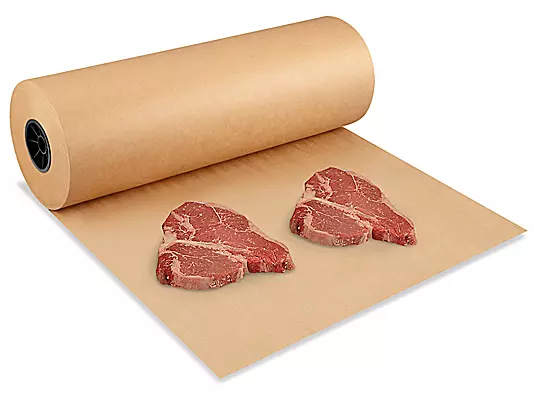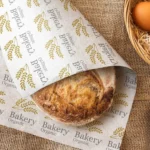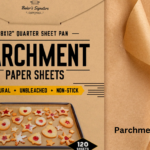When it comes to durable and multipurpose paper, we will get acquainted with butcher paper which is widely used to wrap meats, doing some creations and industrial purposes. Butcher paper comes in various weights and grades and deciding on the weight, is important, even if you are looking for, ‘heavy-duty’. In this article, you will learn about what weight of butcher paper is considered to be effective in the heavy-duty, what tasks this type of paper can be used for, and why this type is perfect for difficult work.
Understanding Butcher Paper
Kraft butchers paper is one of the most used papers in the food sector and arts and creation industries as well as industries. Also made from the wood pulp, a feature of this type of paper is high durability and its resistance to moisture. Butcher paper can be of any colour but white and brown are the most prevalent ones, it can be treated or untreated depending on its application.
Length: It is preferred that butcher paper is light in weight, often measured by pounds per 500 sheets depending on the size. It is directly proportional to the thickness and strength of the each type of paper, so it becomes crucial for the selection of an ideal type.
Weight Categories of Butcher Paper
The weight of butcher paper varies from light-weighted to the heavy weighted grades. Here are the common weight categories:
Light-Duty Butcher Paper (30-40 lb):
Due to its thin texture, this paper is suitable for wrapping Lightweight items or for a short time use.
Found in various arts and crafts projects, as disposable table cloths, or in lightweight product packaging.
Medium-Duty Butcher Paper (40-50 lb):
This grade is tougher and best for mid-traffic applications.
Many times used for wrapping deli meats and cheeses and fish, as well as for craft projects like gift wrap.
Heavy-Duty Butcher Paper (50-70 lb and above):
With thickness varying from 15 to 50 microns and high density making it heavier, specific types of thick and highly durable butcher paper can meet very hard use.
Preferably used in covering big chucks of meat, barbeque smoking, and in industrial uses.
What makes heavy duty butcher paper?
The classification of heavy-duty butcher paper is defined as any butcher paper with a weight that is at least of 50 lb. This weight also translates into reinforcing the paper and making it resistant to tear when stressed. The more paper makes it thick the more strong it turns to be in that it is used for hard tasks that demand it to be strong or rather be heavy.
Key Features of Heavy-Duty Butcher Paper:
High Tear Resistance:
This material can support fairly high pressure and is less inclined to shear or puncture even when moving some of the sharp or BIG items.
Moisture Resistance:
Most professional butcher paper products are water resistant, non-stick or coated with a layer that prevents penetration by water and oil.
Heat Resistance:
Though there is a variety, when it comes to smoker papers, some butcher papers labeled heavy duty for barbecues do not melt hence can well be used in smoking meats.
Thickness and Density:
Heavy-duty butcher paper has great thickness that makes it suitable in some uses that need extra padding or protection.
Uses of Heavy-Duty Butcher Paper
Professional kitchens benefit from using smooth heavy-duty butcher paper in numerous ways in both commercial and domestic applications. Here are some of its most common applications:
- Food Industry:
Straight-up white butcher paper is described as thick, heavy duty and commonly used in butcher shops, delis and restaurants. It’s elasticity and water proof characteristic makes it most suitable for the packaging of fresh meat such as chickens, beef and even fish. Apart from this it is used commonly in barbeque culture for smoking the briskets, ribs and other organs of meat. Also referred to as ‘peach paper’ when unbleached and untreated, this type effectively.soaks in meat moisture while permitting smoke to permeate and improve taste.
- Industrial Use:
In the industries, it is employed as the outer layer of wrapping especially in the transport of meat and other edibles, as a coating material when painting or sanding furniture or cabinets or as a cover on the working surfaces in factories. It is useful where abrasion or impact is expected to be a factor due to it’s bullishness.
- Arts and Crafts:
Butcher paper is highly recommended for artists and hobbyists who engage in large projects since the paper is extremely heavy duty. Due to it thickness and abstraction, it is good for painting or drawing, artists can use it to make banners or other forms of decorations.
- Packaging and Wrapping:
Glossy or wax butcher paper is thick and typically used for wrapping heavy or sharp products where extra layer of paper is needed than in regular paper. This endearing quality of poly foam makes it ideal for gift wrap or shipping of some industrial equipment or parts.
- Agriculture and Gardening:
That’s why farmers and gardeners also call heavy-duty butcher paper an ideal biodegradable mulch or protective cover for seeds or any type of produce. The projector thus has the capability to stand different outdoor climates for an elongated period.
Depending on What You Want: How to Get the Most out of Training Weights
When selecting heavy-duty butcher paper, consider the following factors:
Purpose:
When smoking meats, choose uncoated 60 lb peach poster paper also known as the worst lil pilgrim but can breathe easily.
While for some industrial uses, one may need a 70 lb treated butcher paper since it can easily deal with grease, moisture, or extra usage.
Durability Requirements:
When the paper will be used for a highly stressed or frequently loaded item then the weight of 60 lb or more should be selected.
Size:
Butcher paper comes in rolls and sheets. There are always limits to what is achievable with the dimensions required for your specific task and it is better to at least avoid wastage or inconvenience.
Treated vs. Untreated:
The extended use of treated butcher paper is evident where food services are require due to its water and grease resistant nature. Raw paper has its advantages for those applications, which demand the material’s ability to ‘breathe’ or its ability to degrade.
Other Related Substitutes to Heavy-Duty Butcher Paper
While butcher paper is a fantastic choice for many applications, there are alternatives if heavy-duty performance is required:
Freezer Paper:
Glossy paper which comes coated on one side by a plastic layer is the best alternative for wrapping meat for freezing. However it’s slightly less permeable to air than butcher paper.
Parchment Paper:
Parchment paper is best for baking or cooking purposes where the paper should stand heat to improve its non-stick status.
Kraft Paper:
It may be opaque, smoothe, brown colored and strong enough like butcher paper, however, does not possess the specific anti moisture/ grease feature of treated butcher paper causing it to fail in food related uses.
Conclusion
That is why 50 lb of heavy-duty butcher paper and even more can be considered a miraculous helper in various work situations. The manufacturing material is used for making food packaging, industrial uses, art projects, and many other uses due to its strength, non-tear quality, and moisture resistance. If you are choosing the apt butcher paper you have to know about the weight, size and if the paper you are using is treated or untreated. Thus, equipped with the correct heavy duty butcher paper it is always possible to get extremely high performance and durability in the most challenging tasks.







